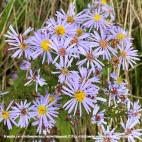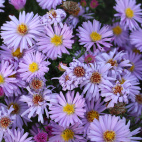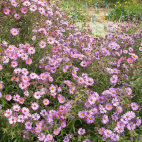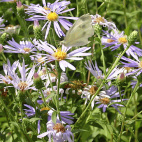Color
Availability
USDA Zone
Region
Type
Duration
Season
Germination
Soil
Sunlight
Height
Use
Narrow Your Search
Color
Availability
USDA Zone
Region
Type
Duration
Season
Germination
Soil
Sunlight
Height
Use
Wildflowers - Aster Seeds
Most plants in the Aster family bloom in the late summer or early fall, with some species being the last thing to bloom before snowfall. This means that Asters fill a crucial role in the fall season of providing nectar and pollen for pollinators like honeybees, and butterflies. lso, they fill a beautiful role in the prairie ecosystem of some nice colors late in the season! There are many species of Asters, and they vary in size and color, but New England Aster is probably the most popular species that we sell. Don't worry, though - there are a lot of species of wildflower seeds here for you to order in bulk. Most of our Aster seeds for sale are perennials, but watch out for the few in here that are from the Callistephus genus - these are annuals. Taxonomists have come up with some new classifications for Asters in recent years, but we have stuck with the simple genus name of Aster for now.
-
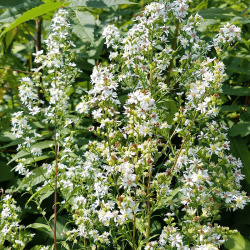 Out Of Stock
Forked Aster Seeds
Aster furcatus
Though rare, this woodland aster can still be found occasionally in the midwestern United States. The delicate, white flower will improve any landscape, and provide a late-season nectar source for pollinators.Quick Viewx
Out Of Stock
Forked Aster Seeds
Aster furcatus
Though rare, this woodland aster can still be found occasionally in the midwestern United States. The delicate, white flower will improve any landscape, and provide a late-season nectar source for pollinators.Quick ViewxForked Aster Seeds
Aster furcatus
Though rare, this woodland aster can still be found occasionally in the midwestern United States. The delicate, white flower will improve any landscape, and provide a late-season nectar source for pollinators.
$3.48 Pkt - $32.00 / Oz -
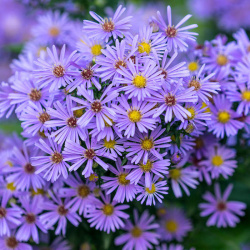 Out Of Stock
New York Aster Seeds
Aster novae-belgii
With bright yellow centers and showy purple-pink petals, these flowers are sure to make a splash. This particular variety was cultivated as early as the eighteenth century.Quick View$3.48 Pkt - $32.00 / Oz
Out Of Stock
New York Aster Seeds
Aster novae-belgii
With bright yellow centers and showy purple-pink petals, these flowers are sure to make a splash. This particular variety was cultivated as early as the eighteenth century.Quick View$3.48 Pkt - $32.00 / Oz -
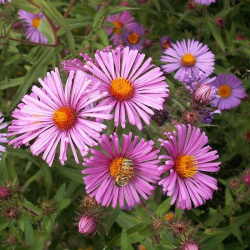 Out Of Stock
Pink New England Aster Seeds
Aster novae-angliae
Blooming in pink profusion, with some shades of purple, this vigorous variation is sure to brighten up your fall meadow. This native makes a great late season nectar and pollen source for pollinators.Quick Viewx
Out Of Stock
Pink New England Aster Seeds
Aster novae-angliae
Blooming in pink profusion, with some shades of purple, this vigorous variation is sure to brighten up your fall meadow. This native makes a great late season nectar and pollen source for pollinators.Quick ViewxPink New England Aster Seeds
Aster novae-angliae
Blooming in pink profusion, with some shades of purple, this vigorous variation is sure to brighten up your fall meadow. This native makes a great late season nectar and pollen source for pollinators.
$3.75 Pkt - $60.00 / Oz -
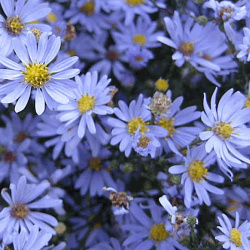 Out Of Stock
Rice Button Aster Seeds
Aster dumosus
These cheery, little flowers are as bright as a button. This notably adaptable species can be found growing wild in areas as diverse as sandy soil, open woods, bogs, or along roadsides.Quick Viewx
Out Of Stock
Rice Button Aster Seeds
Aster dumosus
These cheery, little flowers are as bright as a button. This notably adaptable species can be found growing wild in areas as diverse as sandy soil, open woods, bogs, or along roadsides.Quick ViewxRice Button Aster Seeds
Aster dumosus
These cheery, little flowers are as bright as a button. This notably adaptable species can be found growing wild in areas as diverse as sandy soil, open woods, bogs, or along roadsides.
$3.96 Pkt - $136.00 / Oz -
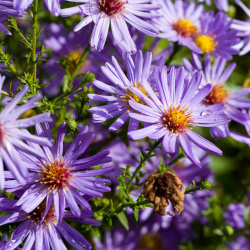 Out Of Stock
Showy Aster Seeds
Aster spectabilis
This New England native has become endangered in some states, though it can be found occasionally in coastal, sandy areas or open woods. Adaptability to almost any soil makes Aster Spectabilis an excellent choice for gardens or prairie plantings.Quick View$3.48 Pkt - $32.00 / Oz
Out Of Stock
Showy Aster Seeds
Aster spectabilis
This New England native has become endangered in some states, though it can be found occasionally in coastal, sandy areas or open woods. Adaptability to almost any soil makes Aster Spectabilis an excellent choice for gardens or prairie plantings.Quick View$3.48 Pkt - $32.00 / Oz
Most plants in the Aster family bloom in the late summer or early fall, with some species being the last thing to bloom before snowfall. This means that Asters fill a crucial role in the fall season of providing nectar and pollen for pollinators like honeybees, and butterflies. lso, they fill a beautiful role in the prairie ecosystem of some nice colors late in the season! There are many species of Asters, and they vary in size and color, but New England Aster is probably the most popular species that we sell. Don't worry, though - there are a lot of species of wildflower seeds here for you to order in bulk. Most of our Aster seeds for sale are perennials, but watch out for the few in here that are from the Callistephus genus - these are annuals. Taxonomists have come up with some new classifications for Asters in recent years, but we have stuck with the simple genus name of Aster for now.








